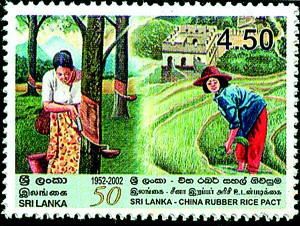When rice was bartered for rubber between Ceylon and China
View(s):60th Anniversary of the Sino-Lanka Rubber-Rice Pact
By Nihal Mallikaaratchi
This December marks the 60th anniversary of the historic Rubber-Rice Pact between Sri Lanka (then Ceylon) and the People’s Republic of China signed on December 18, 1952.
It was signed by then Minister of Commerce, late R. G. Senanayake and his Chinese counterpart in the presence of then Prime Minister of China, Zhou En Lai in Beijing (then Peking). This was five years before establishing diplomatic relations, and was the first trade agreement signed by China with a non-communist country.
In the early 50′s, there was a world shortage of rice which created a sharp increase in the international market price. That was a period when the government of Ceylon was committed to provide two measures of rice per week to every person, at a subsidized price. Despite the shortage and exorbitantly high price, the government was compelled to buy its requirement to feed the nation. But it didn’t have sufficient foreign funds to continue with the purchases, and furthermore the rice obtained from the United States and Ecuador was not to the taste of the Sri Lankan palate.
During the same period the international demand for natural rubber decreased due to the introduction of synthetic rubber as a substitute, which resulted in lowering the price of the natural rubber, on which export Sri Lankan economy depended. Thus, Sri Lanka had to face a severe economic crisis.
This was a period when China had a surplus of rice, whilst experiencing difficulties in purchasing their requirement of natural rubber due to competition between the western capitalist countries and the Asian communist countries. The United Nations imposed a resolution prohibiting Malaya (before it broke up into Malaysia and Singapore) exporting their natural rubber to China which aggravated the problem further.
R. G. Senanayake, who was the Minister of Commerce at the time, observed this situation and proposed signing a barter trade agreement with China under which Ceylon would supply natural rubber and China to reciprocate with rice, which will be beneficial to both countries. Though this was a period when Sri Lanka was politically favouring the western countries, the prevailing local conditions made the Ceylonese government to take a bold decision to sign the proposed barter agreement. And the “Ceylon – China Rubber – Rice Pact” was signed between the two countries on December 18, 1952, in Peking, China.

Picture shows the Commemorative Stamp issued to mark the 50 years of signing the Rubber Rice Pact.
The pact was initially made effective for a period of five years, with the quantities of imports and exports to be balanced annually. The agreement provided provisions for renewal by mutual consent, and it was renewed every five years for six times, and was in effect until 1982. The Sino-Lanka Rubber Rice Pact (as it was popularly known) was the most beneficial and successful trade agreement negotiated by then Ceylon and had been in operation for 30 years. This agreement provided many positive benefits to Sri Lanka, because China appreciated the bold action taken by Sri Lanka, in offering to supply natural rubber, during an era, when all other rubber producing countries declined to supply due to western pressure.
The country was benefitted by supplying the rubber at a higher price than the international price prevailed at the time, and China supplying the rice at a price lower than the world market price. We should be grateful to China because they never tried to bargain on prices or tried to exploit the market to their advantage. China continued to purchase Sri Lanka’s rubber at a higher price, even when other producers were prepared to sell them rubber at lower prices. During the early period of the Rubber – Rice Pact, China even assisted Ceylon to replant the uneconomical rubber plantations, by granting around Rs 125 million to cover a part of the cost.
By the early eighties, Sri Lanka became almost self-sufficient in rice, and large imports were not required any further. At the same time, China was able to purchase its requirement of natural rubber without any restriction from the producing countries. The pact was then considered to be non-effective.
The Rubber- Rice Pct was the starting point for the expansion of bilateral trade between Sri Lanka and China, leading its way to closer and stronger economic cooperation between the two countries. It was promptly followed by the establishment of diplomatic relations with China, in 1957.
Mr Senanayake should be given the full credit of establishing the Rubber – Rice Pact having foreseen that China will very soon emerge as a world super power. The Sri Lanka China Business Cooperation Council, jointly with the Sri Lanka China Society, rightfully remembered and honoured him at a public ceremony organized to commemorate the Golden Jubilee of the signing of the Sri Lanka – China Rubber-Rice Pact held on 20th December 2002, at the BMICH, Colombo, by recognizing in person his beloved wife, the late Mrs. R.G. Senanayake.
The keynote address was made by Dr. J.B. Kelegama on “The significance of the Ceylon – China Trade agreement of 1952″, which covered all the details pertaining to the Rubber – Rice Pact and its advantages gained by Sri Lanka. A commemorative stamp and a first day cover were issued at this event, and a special full page newspaper supplement was published to mark the occasion.
The Rubber – Rice Pact, though is not in effect at present, paved the way to establish and strengthen the bi-lateral business relationship between Sri Lanka and the Peoples’ Republic of China.
The writer is President of the Sri Lanka China Business Cooperation Council from 2002 to 2012).
Follow @timesonlinelk
comments powered by Disqus


















